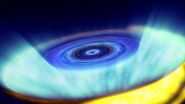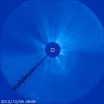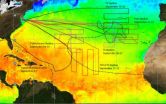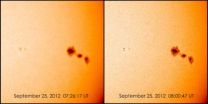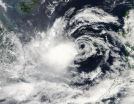(Press-News.org) The HIV protease inhibitor, Nelfinavir, can be used to treat HER2-positive breast cancer in the same capacity and dosage regimen that it is used to treat HIV, according to a study published October 5 in the Journal of the National Cancer Institute.
Breast cancer is one of the most common causes of cancer deaths in the U.S. with approximately 39,520 women succumbing to the disease in 2011. HER2-postive breast cancer is known to be more aggressive and less responsive to treatments compared to other types of breast cancer. Nelfinavir has been shown to inhibit the growth of some types of cancers and has been used in clinical trials as either a chemotherapeutic agent or a radiosensitizer for cancer therapy. However, its effect on HER2-positive breast cancer is unknown.
In order to determine the effects of Nelfinavir on HER2-positive breast cancer, Joong Sup Shim, Ph.D., of the Department of Pharmacology and Molecular Sciences at Johns Hopkins School of Medicine and colleagues screened the Johns Hopkins Drug Library and identified a number of inhibitors of breast cancer cells, a subset of which was then used to pharmacologically profile seven genotypically individual breast cancer cell lines. After identifying Nelfinavir as a selective inhibitor of HER2-positive cells, the researchers determined the antitumor activity of the inhibitor in mouse models of human breast cancer.
The researchers found that Nelfinavir inhibited the growth of HER2-positive tumors in mice. They also found that the concentrations of Nelfinavir needed to inhibit HER2-positive cancer cells in vitro are consistent with dosage regimens used for HIV patients. "With a relatively low toxicity profile and much available information on its drug-drug interactions and on pharmacokinetics, Nelfinavir is ready for clinical testing in HER2 breast cancer patients," the authors write, adding that this discovery has, "important implications in the development of Nelfinavir and its analogs as new anticancer agents."
###
Contact Info:
Jun O. Liu, Ph.D., joliu@jhu.edu
HIV drug shows efficacy in treating mouse models of HER2+ breast cancer
2012-10-06
ELSE PRESS RELEASES FROM THIS DATE:
Superheroes needed to tackle timebomb of public health challenges
2012-10-06
Public health 'superheroes' are needed to help tackle the growing challenges posed by obesity, alcohol, smoking and other public health threats, according to new research published today.
The research, an international collaboration from the Universities of Leeds, Alberta and Wisconsin, calls for government and policy makers to recognise the role that public health leaders can play in addressing these significant health challenges.
It suggests that potential public health 'superheroes' can come from both within public health disciplines, and perhaps more importantly, ...
Whether we like someone affects how our brain processes movement
2012-10-06
Hate the Lakers? Do the Celtics make you want to hurl? Whether you like someone can affect how your brain processes their actions, according to new research from the Brain and Creativity Institute at USC.
Most of the time, watching someone else move causes a 'mirroring' effect – that is, the parts of our brains responsible for motor skills are activated by watching someone else in action.
But a study by USC researchers appearing Oct. 5 in PLOS ONE shows that whether or not you like the person you're watching can actually have an effect on brain activity related to ...
Testing can be useful for students and teachers, promoting long-term learning
2012-10-06
Pop quiz! Tests are good for: (a) Assessing what you've learned; (b) Learning new information; (c) a & b; (d) None of the above.
The correct answer?
According to research from psychological science, it's both (a) and (b) – while testing can be useful as an assessment tool, the actual process of taking a test can also help us to learn and retain new information over the long term and apply it across different contexts.
New research published in journals of the Association for Psychological Science explores the nuanced interactions between testing, memory, and learning ...
Mount Sinai researchers find mechanism of opiate addiction is completely different from other drugs
2012-10-06
Chronic morphine exposure has the opposite effect on the brain compared to cocaine in mice, providing new insight into the basis of opiate addiction, according to Mount Sinai School of Medicine researchers. They found that a protein called brain-derived neurotrophic factor (BDNF), which is increased in cocaine addiction, is inhibited in opioid addiction. The research is published in the October 5 issue of Science.
"Our study shows that BDNF responds completely differently with opioid administration compared to cocaine," said Ja Wook Koo, PhD, Postdoctoral Fellow in ...
Methadone reduces the risk of HIV transmission
2012-10-06
This press release is available in French.
Methadone reduces the risk of HIV transmission in people who inject drugs (PWID), as reported by an international team of researchers in a paper published today in the online edition of the British Medical Journal. This team included Dr. Julie Bruneau from the CHUM Research Centre (CRCHUM) and the Department of Family Medicine at the Université de Montréal.
"There is good evidence to suggest that opiate substitution therapies (OST) reduce drug-related mortality, morbidity and some of the injection risk behaviors among PWID. ...
NASA's Swift satellite discovers a new black hole in our galaxy
2012-10-06
WASHINGTON -- NASA's Swift satellite recently detected a rising tide of high-energy X-rays from a source toward the center of our Milky Way galaxy. The outburst, produced by a rare X-ray nova, announced the presence of a previously unknown stellar-mass black hole.
"Bright X-ray novae are so rare that they're essentially once-a-mission events and this is the first one Swift has seen," said Neil Gehrels, the mission's principal investigator, at NASA's Goddard Space Flight Center in Greenbelt, Md. "This is really something we've been waiting for."
An X-ray nova is a short-lived ...
Sun spits out a coronal mass ejection
2012-10-06
At 11:24 p.m. EDT on Oct. 4, 2012, the sun unleashed a coronal mass ejection (CME). Not to be confused with a solar flare, which is a burst of light and radiation, CMEs are a phenomenon that can send solar particles into space and can reach Earth one to three days later. Experimental NASA research models show the CME to be traveling at about 400 miles per second.
When Earth-directed, CMEs can affect electronic systems in satellites and on Earth. CMEs of this speed, however, have not generally caused major effects in the past. Further updates will be provided if needed.INFORMATION:
NOAA's ...
NASA's HS3 mission thoroughly investigates long-lived Hurricane Nadine
2012-10-06
NASA's Hurricane and Severe Storm Sentinel or HS3 scientists had a fascinating tropical cyclone to study in long-lived Hurricane Nadine. NASA's Global Hawk aircraft has investigated Nadine five times during the storm's lifetime.
NASA's Global Hawk also circled around the eastern side of Hurricane Leslie when it initially flew from NASA's Dryden Research Flight Center, Edwards Air Force Base, Calif. to the HS3 base at NASA's Wallops Flight Facility, Wallops Island, Va. on Sept. 6-7, 2012.
Nadine has been a great tropical cyclone to study because it has lived so long ...
Getting NASA's SDO into focus
2012-10-06
From Sept. 6 to Sept. 29, 2012, NASA's Solar Dynamic Observatory (SDO) moved into its semi-annual eclipse season, a time when Earth blocks the telescope's view of the sun for a period of time each day. Scientists choose orbits for solar telescopes to minimize eclipses as much as possible, but they are a fact of life -– one that comes with a period of fuzzy imagery directly after the eclipse.
The Helioseismic and Magnetic Imager (HMI) on SDO observes the sun through a glass window. The window can change shape in response to temperature changes, and does so dramatically ...
NASA sees very strong wind shear battering Tropical Storm Gaemi
2012-10-06
It is easy to see the effect of the strong northeasterly wind shear battering Tropical Storm Gaemi in satellite imagery from NASA. Visible imagery on Oct. 5 shows a large oval-shaped area of showers and thunderstorms associated with the storm, southwest of the exposed center of circulation.
NASA's Aqua satellite passed over Tropical Storm Gaemi as it was approaching Vietnam on Oct. 5, 2012 at 0550 UTC (1:50 a.m. EDT). A true-color image of the storm was captured by the Moderate Resolution Imaging Spectroradiometer (MODIS) instrument and shows bulk of showers and thunderstorms ...
